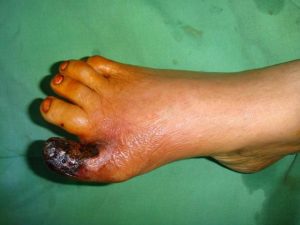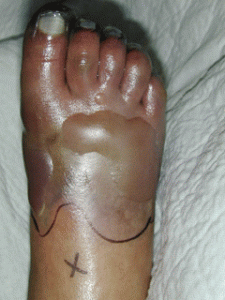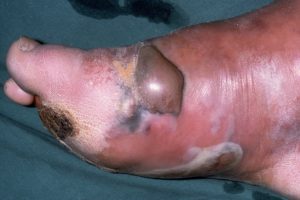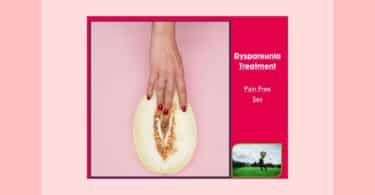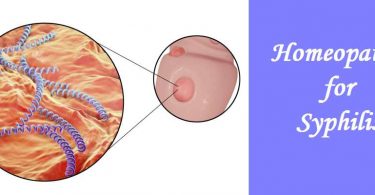Are you looking for a homeopathic cure for Gangrene ? This article discusses the homeopathy treatment of Gangrene along with the best homeopathic medicine for Gangrene treatment.
Gangrene is defines as death of a body tissue which is caused due to loss of blood supply or inadequate blood supply to the tissue.
Symptoms of Gangrene
- Change in skin color to red or black
- Numbness
- Pain
- Skin breakdown
- Coolness
Types of Gangrene
Dry gangrene
Dry gangrene develops in ischemic tissue, where the blood supply is inadequate to keep tissue viable. It is not a disease itself, but a symptom of other diseases.Dry gangrene is often due to peripheral artery disease, but can be due to acute limb ischemia. The limited oxygen in the ischemic limb limits putrefaction and bacteria fail to survive. The affected part is dry, shrunken, and dark reddish-black. The line of separation usually brings about complete separation, with eventual falling off of the gangrenous tissue if it is not removed surgically, a process called autoamputation.
Wet gangren
In wet gangrene, the tissue is infected by saprogenic microorganisms (Clostridium perfringens or Bacillus fusiformis, for example), which cause tissue to swell and emit a fetid smell. Wet gangrene usually develops rapidly due to blockage of venous (mainly) or arterial blood flow. The affected part is saturated with stagnant blood, which promotes the rapid growth of bacteria. The toxic products formed by bacteria are absorbed, causing systemic manifestation of sepsis and finally death. The affected part is edematous, soft, putrid, rotten, and dark.
Gas gangrene
Gas gangrene is a bacterial infection that produces gas within tissues. It can be caused by Clostridium, most commonly alpha toxin-producing C. perfringens, or various nonclostridial species. Infection spreads rapidly as the gases produced by the bacteria expand and infiltrate healthy tissue in the vicinity.
Causes of Gangrene
- Vascular – gangrene is seen is vascular diseases such as peripheral arteriosclerosis, thrombosis of the large arteries, thrombosis of terminal aorta etc.
- Infection – gangrene is mainly produced by clostridium perfringens, and other clostridia, bacteria such as streptococcal, staphylococcal may also produce certain forms of gangrene.
- Neoplasm – multiple myelomas are generally associated with Raynaud phenomenon which produces gangrene.
- Neurological – peripheral neuropathy, syringomyelia, trasverse myelitis, may be associated with gangrene.
- Intoxication – should keep in mind that use of ergot alkaloids may also be associated with gangrene.
- Trauma – laceration of major artery of extremities or pressure from splinters may cause gangrene.
- Decreased temperature – extremes of cold may produce frostbite which can ultimately lead to gangrene.
- Autoimmune diseases such as lupus erythematosus, sclerederma and rheumatoid arthritis may be associated with Raynaud phenomenon and gangrene.
- Endocrine – gangrene can be associated with diabetes.
Homeopathic treatment of Gangrene
Homeopathy is one of the most popular holistic systems of medicine. The selection of homeopathic medicine for gangrene is based upon the theory of individualization and symptoms similarity by using holistic approach. This is the only way through which a state of complete health can be regained by removing all the sign and symptoms from which the patient is suffering. The aim of homeopathic medicine for gangrene is not only to treat gangrene symptoms but to address its underlying cause and individual susceptibility. As far as therapeutic medication is concerned, several remedies are available to treat gangrene that can be selected on the basis of cause, sensations and modalities of the complaints. For individualized remedy selection and treatment, the patient should consult a qualified homeopathic doctor in person. There are following remedies which are helpful in the treatment of gangrene symptoms:
Arsenic album – Dry gangrene in old people, soreness and burning relieved by warmth, restlessness. It is often indicated in gangrene of the lungs. Secale is aggravated by warmth, thus differing from Arsenicum. Arsenicum has a foetid diarrhea, great weakness, emaciation, and coldness and heat alternately.
Bromium – hospital gangrene; cancerous ulcers on face; stony hard swelling of glands of lower jaw and throat
Carbo veg – senile and humid gangrene in the persons who are cachectic in appearance; great exhaustion of vital powers; marked prostration; foul smell of secretions; indolent ulcers, burning pain; tendency to gangrene of the margins; varicose ulcers.
Bothorps – homeopathic medicine for gangrene has swollen, livid, cold with hemorrhagic infiltration; malignant erysipelas.
Echinacea – homeopathic medicine for gangrene enlarged lymphatics; old tibial ulcers; gangrene; recurrent boils; carbuncles.
Lachesis – gangrenous ulcers; gangrene after injury; bluish or black looking blisters; vesicles appearing here and there, violent itching and burning; swelling and inflammation of the parts; itching pain and painful spots appearing after rubbing.
Crotolus H –gangrene, skin separated from muscles by a foetid fluid; traumatic gangrene; old scars open again.
Secale cor – pustules on the arms and legs, with tendency to gangrene; in cachectic, scrawny females with rough skin; skin shriveled, numb; mottled dusky-blue tinge; blue color of skin; dry gangrene, developing slowly; varicose ulcers; boils, small, painful with green contents; skin feels too cold to touch yet covering is not tolerated. Great aversion to heat; formication under skin.
Antrhacinum – gangrene; cellular tissues swollen and oedematous; gangrenous Parotitis; septicemia; ulceration, and sloughing and intolerable burning.
Cantharis – tendency to gangrene; vesicular eruptions; burns, scalds, with burning and itching; erysipelas, vesicular type, with marked restlessness.
Mercurius – gangrene of the lips, cheeks and gums; inflammation and swelling of the glands of neck; pains aggravated by hot or cold applications.
Sulphuric acid – traumatic gangrene; hemorrhages from wounds; dark pustules; blue spots like suggillations; bedsores.
Phosphoric acid – medicine for senile gangrene.
Gangrene Cases Cured with Homeopathic Medicine
A Case of Gangrene – by Punit Sarpal
Gangrene – Healing Through Classical Homeopathy – by Seema Mahesh, Mahesh M
Snake Bite Poisoning with Gangrene and Extensive Cellulitis – by Navin Pawaskar


